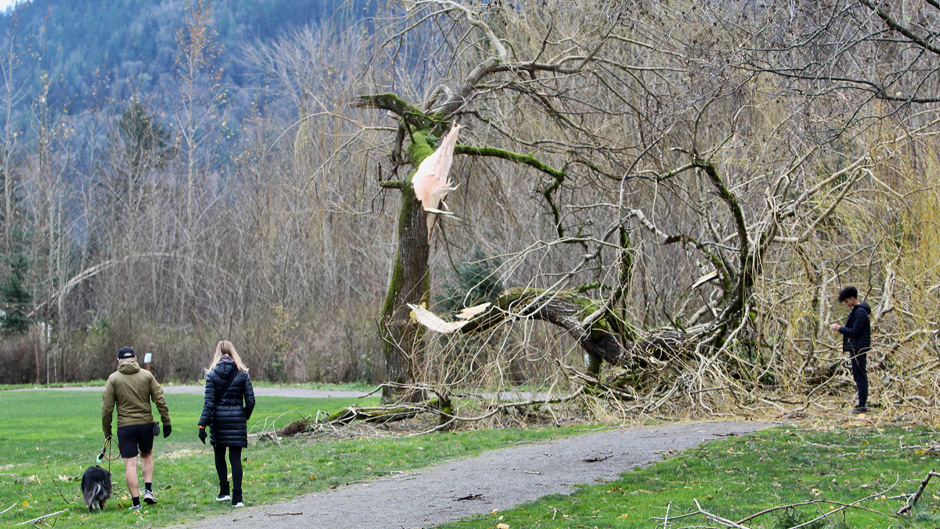The satellite imagery was frightening: a powerful low-pressure system swirling approximately 300 miles off the coast of Washington.
Described as a “bomb cyclone” for the extremely quick drop in pressure that adds to its power, the system battered Northern California, the Pacific Northwest, and British Columbia last week with hurricane-force winds and heavy rain, knocking out power to tens of thousands of homes, downing trees, and killing at least two people.
Why it’s called a bomb cyclone
The expression itself—bomb cyclone—was originally a slang term used to describe an extratropical cyclone that strengthened quickly, a concept similar to a rapidly intensifying hurricane. “This term has been in use for about 80 years but was popularized and formalized 40 years ago when it entered the published literature,” said Brian McNoldy, a senior research associate at the University of Miami Rosenstiel School of Marine, Atmospheric, and Earth Science.
Authors of the paper “Synoptic-Dynamic Climatology of the ‘Bomb,’” which published in the October 1980 issue of the American Meteorological Society’s Monthly Weather Review, called the weather phenomenon a bomb because it develops “with a ferocity we rarely, if ever, see over land.”
“Another term used to describe this is explosive cyclogenesis—rapid formation and development of a cyclone,” McNoldy explained. “To officially qualify as a bomb, the central pressure of the low must fall at least 24 millibars in 24 hours at 60 degrees latitude, or 14 millibars in 24 hours at 30 degrees latitude.”
While the satellite imagery of last week’s bomb cyclone, captured by the National Oceanic and Atmospheric Administration’s GOES 18, looks similar to that of a hurricane, the two systems are structurally different.
Hurricanes are vertically upright, with their structure extending evenly from the ocean surface to the upper atmosphere. And it is such a structure that allows for efficient wind flow and intensification.
“But a midlatitude cyclone is actually tilted in the vertical,” explained Ben Kirtman, a professor of atmospheric sciences and the William R. Middelthon III Endowed Chair of Earth Sciences at the Rosenstiel School. “What’s happening in the upper atmosphere sits to the west with what’s happening at the surface, and it’s that vertical tilt that is so critical for the development of the cyclone. And so, the wind shear is a critical source of energy in the development of the cyclone as opposed to hurricanes, where it’s vertically stacked, and it’s the warm water below that is the source of energy for hurricanes.”
A staple of winter weather
Bomb cyclones are winter storms, occurring primarily from October through March. They also occur off the U.S. East Coast. New England’s infamous nor’easters frequently qualify as bomb cyclones.
The powerful bomb cyclone that devastated the Pacific Northwest last week and eventually combined with an atmospheric river—a long, narrow band of water vapor in the atmosphere that carries moisture from tropical regions to cooler areas—is being called a “once-in-a-decade” storm by meteorologists.
According to data from the National Weather Service, such weather systems are becoming more common, especially along the East Coast. Between 1980 and 2020, the number of bomb cyclones in the Atlantic basin increased by approximately 40 percent, the data reveals.
Could climate change be a driver in the uptick of bomb cyclone? The answer is an intricate one.
“It’s probably connected to warmer ocean temperatures,” Kirtman said. “As the climate system warms, the higher latitudes warm faster than the lower latitudes, and the energy for the system of midlatitude cyclones is that contrast between north and south. And so, your first knee-jerk reaction would be, ‘If it’s warming in the higher latitudes more than the southern latitudes, there’s less energy for these cyclones, less contrast in temperature.’
“But that’s not the whole story,” he continued. “The challenge is what happens when you weaken that polar equator temperature gradient—you get a wavier pattern in the midlatitude wind jet stream. And what that means is it’s able to suck down cold air because it’s wavier; we’re getting these bigger dips. So, you’re getting cold air that’s penetrating further south, and that sets off these midlatitude cyclones. It’s that cold air injection that sets them off. And so, we can get an increase in these systems. So, it’s connected to what’s happening to the warming Arctic, but in a way, we might not think of.”

